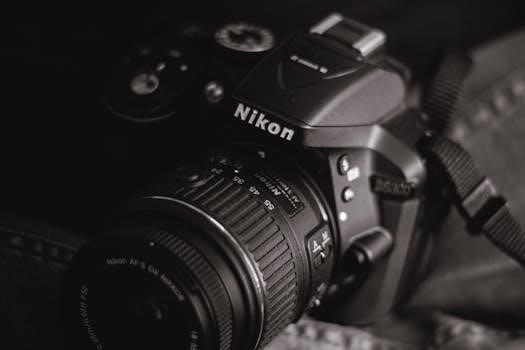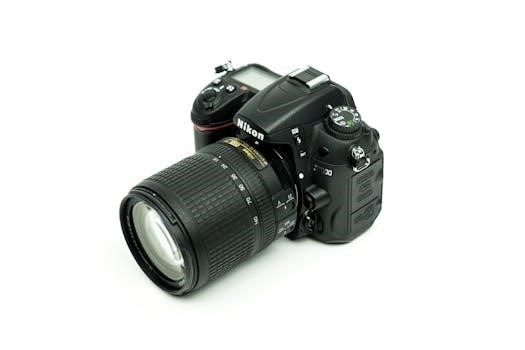
Nikon D70s Owners Manual⁚ A Comprehensive Guide
Welcome to your comprehensive guide for the Nikon D70s! This manual provides detailed instructions‚ ensuring you fully understand your camera’s capabilities. Whether you’re a beginner or experienced user‚ this guide will enhance your photography journey. Explore its features‚ settings‚ and functions with ease.
The Nikon D70s‚ a digital single-lens reflex (DSLR) camera‚ is a fantastic tool for both aspiring and seasoned photographers. Released as an update to the D70‚ it offers a blend of user-friendliness and advanced features. This camera is equipped with a 6.1-megapixel CCD sensor‚ providing detailed images. Its robust build ensures durability‚ making it suitable for various shooting conditions. The D70s is compatible with a wide range of Nikon lenses‚ offering flexibility in focal lengths and perspectives. With its intuitive interface and ergonomic design‚ it feels comfortable in your hands‚ allowing for prolonged shooting sessions. This model is noted for its slightly larger LCD screen compared to its predecessor. The D70s also includes improved flash coverage‚ enhancing its performance in low-light environments. This camera strikes a balance between manual control and automatic settings‚ making it an excellent choice for learning the fundamentals of photography. Its image quality is impressive‚ especially when paired with quality lenses. The D70s is a reliable and capable camera that continues to be favored by many photography enthusiasts. It allows users to learn and grow their skills in photography effectively. The camera’s menu system is user friendly‚ which helps users to navigate options seamlessly. This model is a significant step in the evolution of digital cameras.

Downloading the PDF Manual
Accessing the Nikon D70s user manual in PDF format is a straightforward process‚ allowing you to have a digital copy readily available on your devices. The official Nikon website is the primary source for downloading the manual‚ ensuring you get the most accurate and up-to-date version. Typically‚ the manual is located within the support section‚ under the D70s product page; The PDF file is usually free to download and is compatible with various operating systems. Once downloaded‚ you can view the manual using software such as Adobe Reader‚ which is also available for free. The PDF format allows for easy navigation‚ with searchable text and clickable links to specific sections. This makes finding information quick and efficient. Having a digital copy also means you can access the manual on your smartphone‚ tablet‚ or computer‚ making it convenient for on-the-go reference. You can also print specific pages as needed‚ if you prefer having a hard copy. The PDF manual includes detailed explanations‚ illustrations‚ and diagrams‚ providing a comprehensive guide to your camera’s features and functions. This resource will greatly aid in understanding your D70s camera thoroughly. Always ensure you download from a trusted source to avoid any potentially harmful files. Keep your manual updated as new information becomes available to stay well-informed about all aspects of your D70s camera. This is a key advantage for digital accessibility.
Navigating the Camera Controls
Understanding the array of controls on your Nikon D70s is crucial for capturing the perfect shot. The camera body features various buttons‚ dials‚ and switches‚ each with a specific purpose. The mode dial on the top of the camera allows you to select different shooting modes‚ such as auto‚ program‚ aperture-priority‚ shutter-priority‚ and manual. The command dials‚ typically located near the shutter button‚ adjust settings like aperture and shutter speed. The multi-selector‚ a circular pad on the back of the camera‚ enables navigation through menus and selecting focus points; The menu button gives access to the camera’s settings‚ organized into various categories. The display screen shows current settings‚ image previews‚ and other information. Familiarize yourself with the function buttons‚ usually marked with labels or symbols‚ which offer quick access to commonly used settings. The focus mode switch‚ usually located near the lens mount‚ allows you to choose between autofocus and manual focus. The zoom control on the lens allows for changing the focal length. It is essential to familiarize yourself with all these controls to become proficient with your D70s. Practice adjusting settings while viewing the changes on the LCD screen. By exploring the camera’s layout‚ you’ll gain confidence and be able to shoot effectively and efficiently. Remember‚ each control is designed to offer you precision and artistic freedom. This tactile knowledge is key to great photography.

Understanding Focus Modes⁚ AF and Manual
The Nikon D70s offers two primary focusing modes⁚ Autofocus (AF) and Manual focus (M). Understanding each mode is crucial for achieving sharp‚ clear images. Autofocus automatically adjusts the lens focus to ensure the subject is in focus. The D70s typically uses a single focus point‚ or a dynamic focus area‚ to track moving subjects. In autofocus mode‚ the camera uses a focus sensor to detect the subject and adjust the focus. Autofocus is especially useful for capturing moving subjects or taking quick snapshots. Manual focus‚ on the other hand‚ puts the control of focus in the photographer’s hands. In manual focus mode‚ you adjust the lens’ focus ring to bring the subject into focus. This mode is preferred for situations where autofocus might struggle‚ like shooting through glass or in low light. Manual focus provides more precise control and is often used for creative purposes. To switch between AF and M on the D70s‚ there is usually a switch located on the camera body‚ near the lens mount. When using older lenses‚ you might also have to move the switch on the lens itself. Learning when and how to use each focus mode will significantly enhance your photography. Practice is key to mastering both autofocus and manual focus. Experiment with different subjects and lighting conditions to see which mode works best in various situations.
Exposure Settings⁚ Auto‚ Program‚ Shutter-Priority‚ and Manual
The Nikon D70s offers a range of exposure modes to suit different shooting scenarios and skill levels. The Auto mode is designed for beginners‚ letting the camera automatically set the aperture and shutter speed for optimal exposure. Program mode (P) is a step up‚ allowing the photographer to adjust settings‚ while the camera still chooses aperture and shutter speed. Shutter-priority mode (S) is for when you want to control the shutter speed‚ the camera will then select the corresponding aperture. This is useful for capturing fast-moving objects. Manual mode (M) gives you complete control over both shutter speed and aperture‚ making it ideal for creative photography and challenging lighting conditions. In manual mode‚ you select both settings. Understanding these modes is important for taking control of your photography. The D70s also has three TTL exposure modes‚ including Nikons 3D Color Matrix Metering with 1‚005-pixel RGB Sensor. Each of these modes provides different levels of control. Experimenting with each mode will help you learn how aperture and shutter speed affect your photos. Auto mode is best for beginners. Program mode gives you some control. Shutter-priority allows you to control shutter speed‚ and Manual mode gives full control. Mastering these modes will unlock creative possibilities.
ISO Sensitivity Control
The Nikon D70s provides flexible ISO sensitivity control‚ allowing you to adjust the camera’s sensitivity to light. This setting is crucial for capturing well-exposed images in various lighting situations. The D70s offers an ISO range from 200 to 1600. You can set the ISO manually or allow the camera to control it automatically. Lower ISO values‚ such as 200‚ are ideal for bright‚ sunny conditions‚ producing images with minimal noise and high detail. As light levels drop‚ you can increase the ISO to 400‚ 800‚ or 1600‚ making the camera more sensitive to light. However‚ higher ISO settings may introduce digital noise‚ which can make the image grainier. Understanding how ISO affects your photos is essential for achieving the desired image quality. The automatic ISO function on the D70s can be handy when shooting in changing light‚ but for more creative control‚ manual adjustment is best. The D70s offers a range of ISO settings to match most lighting conditions. Lower ISOs produce cleaner images but require more light. Higher ISOs allow shooting in low light but can introduce noise. Balancing ISO with aperture and shutter speed is key for proper exposure. Experiment to see which ISO setting works best for you.
Lens Compatibility and Image Angle
Understanding lens compatibility and image angle is vital for maximizing the potential of your Nikon D70s. The D70s utilizes the Nikon F mount‚ which is compatible with a wide variety of Nikkor lenses‚ including AF‚ AF-S‚ and DX series lenses. However‚ it’s crucial to note that the D70s has an APS-C sized sensor‚ which affects the angle of view. When using lenses designed for 35mm film cameras‚ the effective focal length is multiplied by approximately 1.5x. This is often referred to as the “crop factor.” For instance‚ an 18mm lens on a D70s will have a field of view similar to a 27mm lens on a full-frame camera. This means the image angle will be narrower compared to the same lens on a full-frame sensor. DX lenses are specifically designed for APS-C sensors like that of the D70s‚ and provide optimal image quality without the need to apply the crop factor. When using older manual focus lenses‚ you may need to manually set the aperture‚ as autofocus may not be available. The D70s is versatile with different lenses. Experiment with various lenses to find what works best for your photography. Understanding these compatibility and angle factors will help you achieve great photos.
Firmware Updates
Keeping your Nikon D70s firmware updated is essential for optimal performance and access to the latest features and bug fixes. Firmware updates are software enhancements that Nikon releases to improve camera functionality‚ address potential issues‚ and ensure compatibility with new accessories or lenses. To check if your camera has the latest firmware version‚ you’ll typically need to navigate through the camera’s menu system. If an update is available‚ you’ll need to download the firmware file from the official Nikon website. It’s critical to use the firmware version specifically designed for your D70s model. The downloaded file is usually transferred to a formatted memory card‚ which is then inserted into your camera. The update process is usually initiated through the camera’s menu‚ and it should be done carefully by following the on-screen instructions to avoid any problems. During the firmware updating process‚ do not turn off the camera and do not remove the battery or memory card because this could lead to the camera being damaged. Regularly checking for updates will ensure your D70s operates smoothly and efficiently‚ allowing you to capture the best possible images.

Basic Photography Guide
Embarking on your photography journey with the Nikon D70s can be both exciting and rewarding. This basic guide provides essential steps to get you started. Begin by understanding the fundamental elements of photography⁚ composition‚ lighting‚ and focus. Composition refers to how you arrange elements within your frame. The rule of thirds is a great starting point for creating balanced and interesting images. Pay attention to the light; it can dramatically change the mood and feel of your pictures. Natural light‚ often called golden hour‚ is particularly flattering. Focus is crucial for sharp images; use the autofocus feature or learn to manually focus using the lens ring. Always ensure your subject is clear and well-defined. Get familiar with the camera’s shooting modes such as auto‚ program‚ and aperture and shutter priority as you progress in your skills. Start with Auto to let the camera determine the best exposure and then explore more manual settings to take control of your photos. Practice regularly‚ and don’t be afraid to experiment with various settings. Review your photos and learn from your mistakes.
Troubleshooting and FAQs
Encountering issues with your Nikon D70s is not uncommon‚ and this section addresses frequent questions and potential problems. A common issue is blurry images‚ which can often be resolved by checking the focus mode and ensuring your subject is properly in focus. If the camera is not turning on‚ verify that the battery is charged and correctly inserted. Error messages on the LCD screen indicate a problem; consult your manual for specific error code meanings. When facing exposure problems‚ confirm your ISO settings and metering mode. If your images appear too dark or too bright‚ adjust the exposure compensation. Lens errors may occur if the lens is not correctly attached. Make sure the lens is securely locked in place. Furthermore‚ if your flash does not fire‚ check the flash settings in the menu. It could be deactivated or not fully charged. Regularly cleaning your lens and sensor will prevent many problems. Always refer to the D70s user manual for details.
Additional Resources and Support
For further assistance beyond this manual‚ several resources are available to support your Nikon D70s journey. Nikon’s official website offers a wealth of information‚ including firmware updates‚ software downloads‚ and detailed product specifications. You can download the user manual in PDF format from their support page for offline access. Online forums and communities dedicated to Nikon cameras are excellent places to ask questions and exchange ideas with fellow photographers. YouTube is another excellent source for video tutorials that demonstrate various features and techniques. Consider joining a local photography club for in-person guidance. Many third-party websites offer guides‚ tips‚ and reviews of the D70s. If you need professional help‚ Nikon authorized service centers can provide technical support and repair services. Remember that keeping your camera’s software up-to-date is vital for optimal performance and functionality. Always ensure you download from reputable sources. When considering third-party resources‚ read reviews to ascertain the reliability of the information provided.
